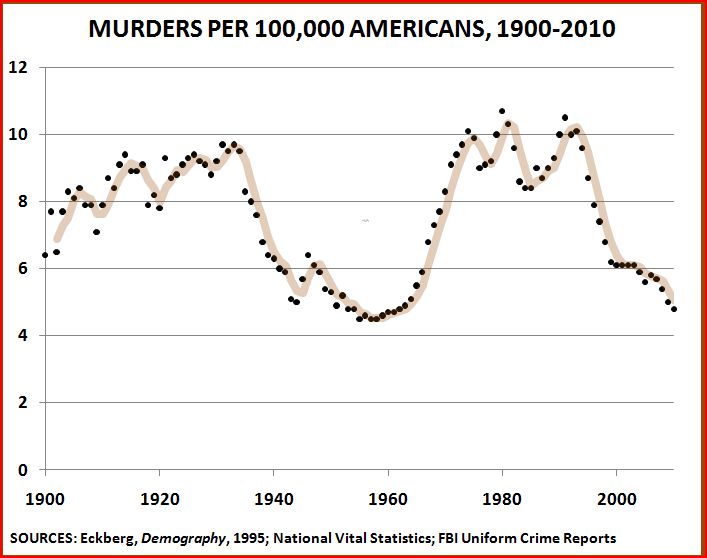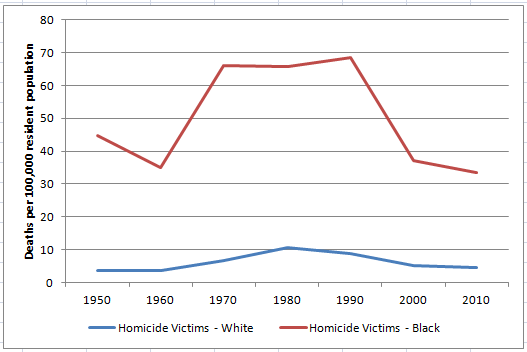The big hobbyhorse issue for libertarians is America’s incarceration rate. They love the issue because they get to prattle on about weed, while sucking up to the Left, who are always looking for an excuse to release felons into your neighborhood. In other words, they get to sound tough about small government in a way that is entirely safe from the wrath of their Progressive masters.
While I think our prison system is a mess, my response to libertarians over the issue is always the same. “How many current inmates would you like released into your neighborhood? On which corner of your block should we put the halfway house?” It’s a fun bit because no has yet provide an answer. Just as it is easy to be generous with other people’s money, it’s easy to be kind to convicts from a great distance.
It’s even easier if you are insane. This story I saw posted on twitter was getting passed around by the usual suspects, suggesting that maybe I’m too soft on libertarians.
What Lind doesn’t talk about is the way that the vast, vastly profitable private prison industry created and lobbied for legislation that criminalized more conduct and set out longer sentences for violations, operating in opaque secrecy, running forced-labor camps, profiteering from prisoners and their families, bribing judges to send black kids to jail, and producing a system where the rich can launder billions for drug cartels without a single criminal prosecution, but poor people caught with minute amounts of weed go to jail for long stretches.
In other words: that hockey-stick growth isn’t an accident.
If you follow the links, you find the Alex Jones type paranoia that has always been a part of the modern Left. Instead of secret government agencies in league with space aliens, you have secret corporate agents in league with aliens. It’s The Deep State™ run out of a corporate boardroom instead of Langley.
Putting all of that aside, it does raise an important question and that is how were we able to have relatively low crime rates, adjusting for race, age and sex, while having a stable prison population. Something changed in the 50’s and 60’s that led to the sudden upward turn in crime. 
The obvious candidate for what changed preceding the spike in murder rates is the Civil Rights Movement. The greatly diminished status of blacks would have suppressed crime rates in two ways. First, the fear of white retaliation would have resulted in high levels of self-policing among blacks. Second, white indifference to black life would have artificially reduced the crime stats.
The trouble with this explanation is that white murder rates did tick up in the 60’s, just off a much smaller base so it was less obvious.
The trouble here is getting good data of crime rates by race from before 1980 is surprisingly difficult. I’ve been searching and this is the best I was able to find. Crime rates by race are slowly becoming forbidden knowledge. Even so, it’s hard to honestly tie the spike in black crime to the Civil Rights Movement without better data showing a bigger spike than we saw in white crime rates.
The more politically correct answer is the proliferation of street drugs and the drug trade. Libertarians love this one, but so does the Left because it conveniently avoids talking about race. The trouble with this explanation is that it assumes people suddenly went insane and started taking massive amounts of street drugs. This is one step away from blaming evil spirits.
The Old Right answer is that general assault on traditional culture that started in the late 50’s and accelerated into the 70’s eventually broke down the traditional ways of controlling crime and other social pathologies like drug taking. The result was a rise in social anarchy. Eventually, we evolved a new way to deal with the problem, which was mass incarceration.
The crime issue is a good example of how public policy is always about trade-offs, Swing the wrecking ball through a social institution and something replaces it. It’s also an example showing how American Liberalism will inevitably end in authoritarianism. As traditional institutions are destroyed, the state flows into the void. The existing organic institutions grow weaker relative to the state, making them easier to knock over.


Since we are talking about armchair responses to issues, I am going to throw out there that the black crime rate spiked about the time that the media began to venerate the black hoodlum culture. Dressing like a criminal, speaking like a criminal, and living the life of a criminal became some sort of twisted status symbols and things to aspire to. Now, as actual black hoodlum culture has begun to prey on the rest of us in the last few years, people have stepped away from walking the walk, even if they still dress and speak like hoodlums.
There are obviously many factors involved, but I think the rise of the Welfare State in the 60’s is the número uno reason that led to the accelerated breakdown of the black family, which led to increased crime and incarceration rates. The same things happened to whites but a couple decades later. Still, blacks do commit more crime and have higher incarceration rates than whites, proportionally. My concern with prisons, undetected by most people unfamiliar either with prisons or Islam, is that many of them have become jihadist recruiting centers. It’s genius, really: a captive audience, disaffected from normal society,… Read more »
[…] Graphs and more found HERE. […]
I have long said, being older than many these days, that when I was young it was the fear of discovery in your own neck of the woods that tended to keep crime down.* If everyone knew you then any bad behaviour would get reported pretty swiftly to one’s parents, though I accept this holds less sway if you had no parents. Nonetheless, it was because people lived in relatively small areas that meant everyone knew who were the bad apples and who to avoid. Take that ‘threat’ away, as I began to see in the ‘seventies as people became… Read more »
It is known that young black males commit the great majority of gun crimes, violent crimes and interracial hate crimes. The total number involved is probably less than two million nationwide, and might be less than one million. This is certainly a manageable number, and a targeted, intense program focusing on young black men would essentially eliminate most crime in the US. Our crime statistics would look like those of a pre-invasion European country.
I’m 59 but my older friends who grew up in ethnic city neighborhoods (mostly Irish or Italian) talk about zip guns. Now the idea of using a homemade .22 would make your average gang banger laugh. But gun control laws were not a significant factor in the 1960’s so why were the murder rates lower? I’m going to venture a guess that a tougher (even if corrupt) city police force would make it less desirable to settle disputes with murder. Conviction of premeditated murder often brought execution in a relatively short time. Last, the seriously mentally ill were then institutionalized.… Read more »
Here’s something that changed in the post-war era – leaded gasoline. Interesting data on the rise of atmospheric lead, followed by the rise in crime, followed by reductions in lead, followed by reduction in crime. http://www.motherjones.com/environment/2013/01/lead-crime-link-gasoline
The lead-crime has been worked over for years and my conclusion is that there is a reason we have the expression “correlation is not causation.” Japan, for example, has higher population density and had leaded gasoline. Lead levels were higher than in the US, but they did not have a crime wave. When you want to associate an environmental factor with a disease, the standard test is to see if the correlation appears in other places. If high levels correspond with high crime everywhere, then you have a good starting point. The real problem with the hypothesis is that no… Read more »
I left correlation/causation out of my comment because I didn’t want to be too wordy (!), but the research done in other western countries appears to lead to the same possible conclusion. You mention Japan, which as a culture still held shame and shaming in high regard for most of last century. They might have had a better grip on their deviants or even more self-control, as that is an important trait there. Or was, anyway.
I agree completely that a smaller world has led to a greater dissolution. I just found that correlation interesting.
Lead/Crime is an interesting hypothesis, but it is one that I was suspicious of from the start because it checks too many narrative boxes for my tastes. A big part of the Progressive project over the last fifty years has been to use science! to explain away what people have observed about humanity for 3,000 years. The other part of it that I find troublesome is that there should be other consequences. Presumably, the lead exposure would have lowered IQ’s but when you correct for population movement, that does not show up. In Baltimore, for example, blacks in the city… Read more »